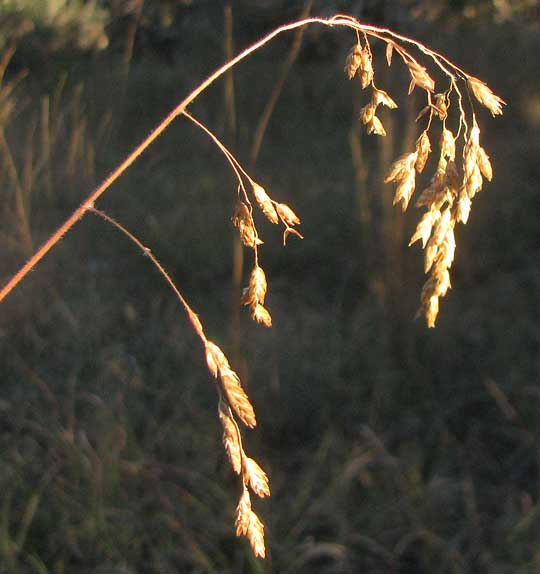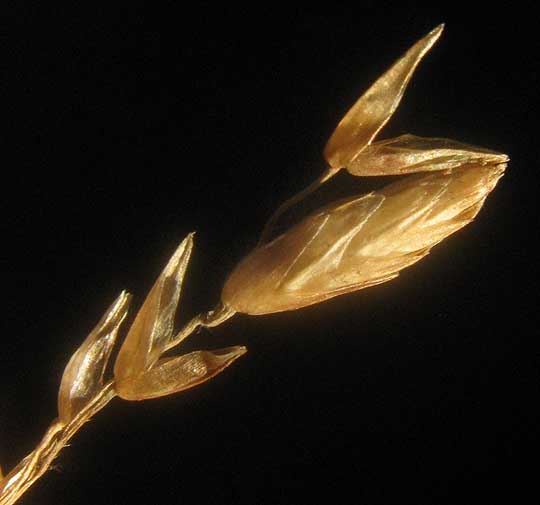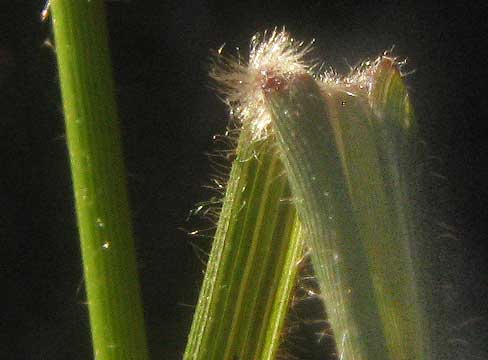Excerpts from Jim Conrad's
Naturalist Newsletter
from the December 1, 2013 Newsletter issued from the Frio Canyon Nature Education Center in the valley of the Dry Frio River in northern Uvalde County, southwestern Texas, on the southern border of the Edwards Plateau; elevation ~1750m (~5750 ft); N29.62°, W99.86°; USA
TEXAS TRIDENS

This late in the season only a few common wildflowers and weeds continue to bloom; already I'm missing the pleasures of their colors and fragrances. In contrast, many grass species now are heavy with mature grains, which pleases sparrows and finches who come foraging, but mostly we've already seen those grass species.
But, in a way, this is when it gets more interesting, for now is the time to start looking for less conspicuous species, the ones that until now have escaped our notice. This week such a fugitive grass turned up and it was a pleasure meeting it. At the right you can see its frost-killed blades and stem topped with a gracefully arcing head of mature spikelets.
A close-up of the head shows that the spikelets are arranged in a panicle, which is a head in which spikelets are held on stems, or pedicels, that arise from other stems, which arise from a main stem, or maybe yet other stems. If the spikelets arose on pedicels directly from a main stem, the head would be a raceme, and if the spikelets bore no pedicels but arose from the main stem directly the head would be a spike. A closer look at this grass's panicle appears below:

A close-up of a complete spikelet beside the remains of three other spikelets that already have dropped their grain-filled florets is shown below:

That picture shows important field marks. First, a single spikelet contains six or more florets. Second, when the florets mature and fall off, they leave the spikelet's lowest two scales, or glumes, still attached to the pedicel. In many grass genera, the glumes fall off as well. A third important field mark is that the glumes are about the same length as each floret's main scale, or lemma. In many grass genera the glumes are much shorter than the lemmas, or much longer, sometimes even longer than the whole collection of florets.
Another important field mark just barely visible in the above picture is that on the top side of the spikelet still containing its florets, the tip of the lowest floret appears to end not with a sharp point, which is typical, but rather with a notch, and a very tiny spine seems to arise at the base of that notch. This is such an important and unusual feature that a floret was placed beneath the dissecting scope, to make sure I wasn't imagining things. Below, you can see a floret's scoop-shaped lemma:

Do you see the notch at the far left? And the short, sharp spine, which actually is the lemma's midrib projecting just a little beyond the notch? Also, the single veins on each of the lemma's sides also end in tiny points, or "mucros."
Another field mark always needing attention when you don't know what genus of grass you're dealing with is the ligule, the little wall-like thing that may or may not occur where the leaf blade meets the stem. Ligules come in many forms, mostly cellophane-like or "membranous," or like a little wall of hairs. This grass's ligule is shown below:

It's mostly hairy, but with a hint of a membranous line, which is very unusual, since usually it's one way or another, not a hybrid situation like this.
So, all these fine field marks lead us right to the Texas Tridens, TRIDENS TEXANUS, found only in southwestern Texas and adjacent arid, northeastern Mexico. This is a fine discovery, a native plant of very limited distribution. Texas Tridens is poorly documented but one source says that it often grows in the protection of shrubs and along fenced road right-of-ways. The plants I've seen have mostly occupied open places on our limestone hillside. The open places might be natural "prairie patches" or where decades ago the trees were removed but which now grasses claim.